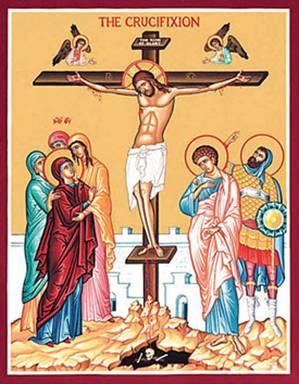Crucifixion
THE CRUCIFIXION
Objectives:
- Students should know the story of Jesus’s arrest, trial, crucifixion, and burial and be able to tell it in their own words.
- Students should be able to identify the characters in the icon and their meaning.
- Why is the cross the universal symbol of Christianity?
Possible Lesson Plan:
Open with prayer.
Scripture References: Matthew 27, Mark 15, Luke 23, John 18-19. Again, divide into 4 groups, each reading one gospel. Report to the rest of the group. Draw a large time-line on the board and fill in the events of Holy Friday. Where was Jesus when He was arrested? What was He doing? What were the disciples doing? How did Judas betray Him? Peter lied about knowing Jesus how many times? Before when? Who was the high priest? The soldiers put what on Jesus? Who condemned Jesus to death? How did He die? Who carried the cross? Why? What are some of the things Jesus said on the cross before He died? Who was crucified with Jesus? What happened when Jesus died? Who took Jesus’s body to his own tomb? Review the story with the icon, identifying the people. What role did each play?
- We celebrate the Crucifixion on Holy Friday. We sing on Thursday about the “Wise Thief”. Which thief was wise and why? We also sing on Friday about “The Noble Joseph”. Who was the noble Joseph? What did he do? Play these beautiful songs if you want with tape or CD from the bookstore. Do you remember what we do in Church on Holy Friday? (Procession, candles, the tomb.)
- Review the major players: Jesus, the 12 disciples (who were they?), myrrh-bearing women (though they haven’t brought the myrrh year, who will they be?), the Pharisees (a group of religious leaders of the Jews particularly devoted to the Torah), the Sadducees (a wealthy priestly aristocracy, concerned with Temple administration and ritual), the scribes (educated civil servants), the Sanhedrin (a senate of 70 priests and laymen, presided over by the high priest), Caiaphas the High Priest, Pontius Pilate the Roman governor, Herod the King, Barabbas the condemned murderer, the 2 thieves, the centurion (the same one who had early sough Jesus out for healing of his servant according to tradition), and Joseph of Arimathea (a wealthy follower of Jesus and member of the Sanhedrin, “the noble Joseph”).
- Play a learning game: Make a Holy Week gameboard. Draw a standard gameboard shape and mark off about 75 spaces between start and finish. Include on some of the spaces events of Holy Week, with penalty or reward, depending on type of event – e.g., Enter Jerusalem in Triumph, go forward 5 spaces, or Betrayed by Judas, go back 3 spaces. One trick – be sure the space to which the player is directed is blank, or he’ll be jumping all over the board. Each player uses a small marker (coin, etc.) and moves the number of spaces tossed by the dice. If no dice? Write 1,2,3,4,5, and 6 on slips of paper and draw one! The design of the game is the most important; if there’s no time to play, perhaps the teacher can duplicate the game for each student and give them out next week for play at home.
- Add to your time line as usual. Again, lots of events. Try to coordinate with last week’s entry.
 Close with prayer. Sing together “Before Thy Cross”.
Close with prayer. Sing together “Before Thy Cross”.
